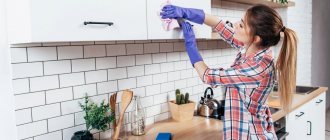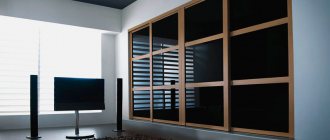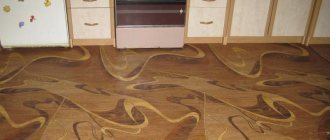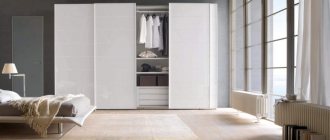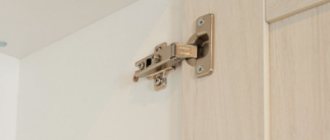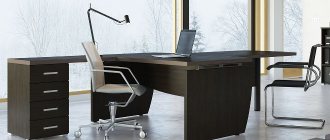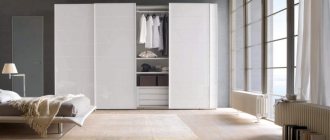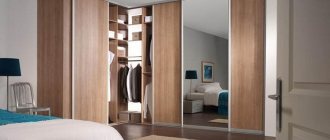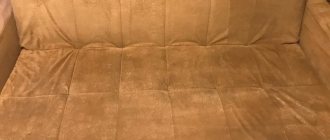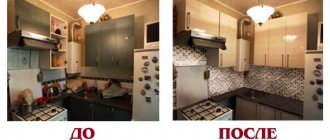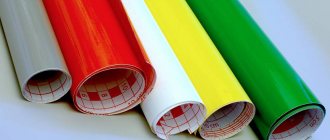Chipboard lamination and lamination technology. Production of laminated chipboard. Decorative coating for furniture boards.
To use chipboard in furniture production, sanded chipboard is subjected to decorative processing - a decorative coating of laminated paper (melamine) films is applied.
At this production site, sanded chipboard is converted into laminated chipboard. The production of laminated chipboards is the process of lining sanded chipboards with paper-based films (laminated paper films).
There are two methods for decorative processing of chipboards with paper-laminated films:
- Chipboard lamination.
- Chipboard lamination.
The main difference between lamination and lamination of chipboards is that during lamination, a decorative coating is created by chemical pressing and is a component of the board, while during lamination, a ready-made solid paper-resin film is glued to the board.
What types of PVC films are there for decorating furniture facades?
Beautiful, functional furniture is a must-have attribute of a home, office or apartment. Cabinet products in furniture production are decorated with facades treated with film material. A coating such as PVC film for furniture facades protects elements from moisture, scratches, damage and has an important decorative function. The coating allows you to implement many interesting ideas and design projects.
- Material characteristics
- Advantages
- Kinds
- Application technology
- Laminating
- Lamination
- Post-formation
- Video
Material characteristics
What is film in furniture design? MDF and chipboard facades are covered with PVC film using special technology. For furniture restoration and decoration, manufacturers produce a wide range of self-adhesive films using the calendering or casting method. In the first case, heated PVC is passed through rollers using high quality polymeric, multi-dimensional plastic. The result is a thin layer applied to a smooth surface.
For structural decoration of furniture elements, the casting method is used. After shrinking, the film coating protects the facade from negative influences. Polyvinyl chloride polymer film has a long service life. In the recyclable materials market, PVC furniture film waste is widely used, used for the manufacture of linings for windows and doorways, and the production of floor skirting boards. Technical characteristics of facade film:
- material thickness – from 0.15 to 0.8 mm;
- roll width is 1400 mm;
- PVC roll length – from 100 to 500 m;
- coatings – glossy, matte, textured;
- decor effect – 3D, hologram, patina, embossing;
- imitation - wood, stone, marble chips;
- color content – a rich range of shades.
Thanks to modern application technology, the coating has optimal strength, rigidity, and elasticity. The service life depends on the quality of the PVC used in the production process, ranging from two to ten years.
With prolonged use, the appearance of the facades of kitchen sets and children's room furniture loses its attractiveness. At home, self-adhesive PVC film helps restore the aesthetic beauty of products.
Video material
- How to sell furniture active sales?
- Adhesive paper for furniture
- How to attach a countertop to a kitchen unit?
So, to laminate chipboard at home, you will need a minimum of tools and materials, as well as an extra pair of working hands. Laminating furniture with film is quite popular; you can use it to laminate facades and tabletops. This way you can get a neatly finished surface without unevenness and air bubbles.
Advantages
The combination of decorative and protective functions is the main advantage of polyvinyl chloride coating. After processing, furniture facades acquire an interesting design in a rich color palette. The film protects products from damage and negative factors. The main advantages of PVC films for furniture facades:
- chemical, physical stability;
- high temperature stability;
- moisture-proof, low absorption;
- resistance to ultraviolet rays;
- presence of antibacterial treatment;
- low thermal conductivity, environmental friendliness;
- strength, protection from scratches, abrasion;
- variability of structure and choice of shades;
- high aesthetic and decorative properties.
The material has absorbent properties (does not absorb moisture). When cleaning and detergent compositions come into contact with surfaces, no damage is caused. It is allowed to use PVC material for finishing furniture intended for rooms with unstable humidity and temperature - kitchens and bathrooms. The coating does not contain toxic substances and protects the wood from fading, moisture and mold formation.
For design purposes, PVC film is an ideal option. Furniture facades can be artificially aged, the surface can be given a metallic effect, and a multi-layer decorative coating can be applied.
Processing elements of various configurations and structures requires the use of a certain type of coating. Film for finishing furniture facades is classified according to texture. The following types of products are available:
- textured PVC films imitating natural materials. Options for wood, natural stone, marble, as well as coatings with designer patterns and abstract designs are in wide demand. The films look especially impressive in the design of kitchen units and MDF countertops;
- glossy coating - reliably protects the facade from external influences and prevents scratches. The glossy film does not peel off during prolonged use and is resistant to moisture. The gloss applied to the facade gives the furniture set a beautiful shine;
- matte material - technical characteristics do not differ from a glossy coating, but has important advantages - stains and dirt are invisible on the matte surface. The furniture does not sparkle or shine, which allows you to avoid glare from the lighting of the room;
- an extensive group of decorative materials for independent furniture design. Self-adhesive is great for restoring facades or designing products in a new way. The self-adhesive film is treated with a compound that ensures reliable fixation of the coating on the furniture surface.
Additionally, the film is decorated with embossed patterns, patination, holographic effects and images in 3D format. Thanks to the variety of colors in the production of furniture, it is possible to implement unusual projects, use combined facades and elements of contrasting shades.
Glossy
Matte
Self-adhesive
Texture
We repaint laminated furniture with our own hands - stages of work
Stage 1 - Preparatory
The laminated surface of any furniture is plastic (polyvinyl chloride, PVC), resistant to water. If you paint such a smooth surface, the paint will not stick, even the most expensive and high-quality one. Therefore, the surface must be carefully prepared. First, you should remove all fat from the surface using special solvents and detergents.
Stage 2 - Sanding the surface
To prevent the paint from falling off after application, the top layer must be removed from the laminated surface. Sandpaper is suitable for this. First, you should use a coarser-grain sandpaper to remove the laminating layer, and then sand the furniture with a fine-grain sandpaper. This treatment will create a rough surface on which the paint will adhere better.
Do not forget to use personal respiratory protection when working, as dust from plastic is quite harmful.
Stage 3 - Sealing cracks
To seal cracks and chips, you need to use either a special composition based on epoxy resin or putty (preferably latex). Before treating cracks, they must be primed and allowed to dry. Then the cracks are sealed and the composition is also allowed to dry completely. A small spatula is used as a tool.
Stage 4 - Surface priming
Priming is a mandatory step before painting. A good quality primer will prevent the paint from peeling and bubbling. Give preference to a polyurethane-based primer; this composition sticks to everything, even glass and ceramic tiles.
If such a composition is not available, then you can purchase a primer in cans intended for painting a car. But when working in it, the presence of a respirator becomes a prerequisite. The soil must dry for at least 12 hours.
If you plan to paint the furniture in a specific color, then the primer can also be tinted in the selected shade to create some kind of “background”.
Stage 5 - Painting
Which paint to choose for laminated furniture? This is the first question that craftsmen ask before painting. Of course, it is better to give preference to special paints marked “for furniture,” but alkyd or polyurethane paints are also an excellent solution. But epoxy-based paints, although they give excellent results, take a long time to dry and stink. You can use such paints only if painting takes place somewhere in a garage or shed.
Chalk paint would be an excellent solution, especially since you can make it yourself.
To paint furniture made of laminated chipboard, you can also choose acrylic paints, but in this case you will have to prime it at least twice beforehand.
As a tool, choose a short-pile velor roller - such rollers paint much better than foam rollers and create an even layer. For hard-to-reach places, such as corners, choose brushes of different sizes (you’ll have to check which one is convenient for you - you’ll have to check it in practice).
So, you will have to paint in two layers, allowing the first layer to dry thoroughly. If suddenly for some reason something cannot be painted over, then this place can be decorated, for example, using the decoupage technique.
Stage 6 - Protection
If repainted furniture is exposed to active moisture or wear (for example, kitchen facades or furniture in the hallway), then applying varnish over the paint would be an appropriate solution. Choose acrylic varnish; both glossy and matte varnishes are available. The varnish is applied either with a brush or a roller to completely dry paint.
So, painting laminated furniture with your own hands is not difficult, especially if you know all the nuances. And after proper preparation, you will actually end up with new furniture, perhaps even better than the old one. And, what can I say, this will still help you save on buying new furniture and get a truly exclusive item.
Application technology
Polymer coatings are the main option for finishing furniture facades. Depending on the complexity of the surface being treated and the type of material, there are three options for applying decorative and protective coatings for furniture - lamination, lamination and post-formatting.
Laminating
The process of covering the base surface with facing materials in order to improve the aesthetic characteristics of the finished product is called laminating. The application technology is carried out at different temperatures using special equipment:
- cold lamination - cold processing of PVC film for furniture facades is suitable for smooth surfaces. The part is covered with glue and a film is rolled under pressure;
- warm lamination - before applying the decorative coating, the glue is heated to release excess moisture. The material is pressed to the surface until the glue polymerizes;
- hot lamination - the technology of film application is carried out at a temperature of 120-160°C using hot rollers of machine equipment.
During the production process, waste PVC furniture film is generated if the material is deformed under heavy load. There are restrictions on the use of lamination when processing chipboard and MDF - the surface must be smooth. The glue securely fixes the PVC and is evenly distributed over the base of the part due to temperature heating and the use of vacuum pressing equipment.
Lamination
When laminating, the product being processed is wrapped in film without applying glue. A durable protective coating is obtained under high temperature and pressure. Lamination technology makes it possible to process structurally complex elements and uneven surfaces. The features of the process are as follows:
- at high temperatures, furniture film becomes plastic;
- under pressure, the material is securely fixed to the base of the facade;
- the technology is suitable for processing elements made of MDF and chipboard;
- rolling film material onto radial facades;
- For crimping, films coated with synthetic resins are used.
The lamination process produces a solid web that is not prone to delamination. Finished products do not allow moisture to pass through and are chemically stable. If a manufacturing defect occurs during the production process, waste PVC furniture film can be used for recycling.
Post-formation
Postforming is considered the most effective way to process MDF facades in furniture production. The essence of the process is to apply a layered coating to the base. The material must withstand the dynamic load of the pressing equipment. Main differences of the technology:
- for post-formation, flat polyvinyl chloride is used;
- process straight, curved, curved, radial facades;
- the coating is applied to the glue, mainly on positioning machines;
- the material is pressed with a press with a relief surface;
- An imprint remains on the façade, giving the product an original texture.
Postforming technology makes it possible to process complex parts coated with a film material of high strength and moisture resistance.
Using various techniques for applying PVC to furniture facades, products can be given an original design. The material is presented in a wide range - there are options in subdued colors that strictly imitate natural materials, and films of bright and variegated colors for complex design compositions.
Do-it-yourself methods for laminating chipboard
Of course, it is impossible to accurately reproduce the factory process of chipboard lamination with your own hands. If only because you have neither professional skills nor specialized equipment. In addition, the compositions used for industrial lamination contain toxic substances.
The best option is laminating:
- Chipboard cladding using self-adhesive film. This is a dense canvas made of synthetic material with an adhesive applied to the reverse side.
Important! It is enough to remove the layer of protective paper and glue the film to the surface. Air bubbles can be removed with a plastic spatula or soft cloth.
- Gluing a film of polymer material using universal glue. The glue is applied to the chipboard and left for a short time. Then the film is carefully glued. For better adhesion, it is rolled with a roller or pressed with a press.
Important! Of the two options given, the second one is more reliable. As practice shows, self-adhesive tape has to be re-glued periodically or a new one must be purchased. The savings are quite dubious. The best option is to purchase chipboard with industrial lamination.
Beds with soft panels at the head: stylish solution and comfort- Ideas for arranging furniture in a small room
- Is it possible to place a bed opposite the door?
Pros and cons of film facades
In addition to the variety of appearance, the advantages of film for MDF facades include:
- low cost;
- simple application technology;
- practicality in operation;
- high moisture resistance;
- good resistance to ultraviolet radiation (fading);
- environmental Safety.
The disadvantages include:
- Relatively low resistance to mechanical stress. The surface is easy to scratch.
- Low upper threshold of operating temperature (about 80°). Therefore, film for a kitchen table is not the best option - even a cup of hot tea can leave a “whitish” mark.
- It is impossible to restore the surface by grinding or polishing.
Kitchen furniture has the highest risk of damage - this is where it experiences high mechanical and thermal loads. But all these shortcomings are compensated by the possibility of updating using self-adhesive film for the kitchen.
Advantages of PVC film
- Wide range of colors and decors (glossy, matte, smooth, embossed, etc.)
- Wear resistance (resistant to mechanical and chemical stress, temperature changes or loss of color, and does not deteriorate from detergents)
- Environmental friendliness (as manufacturers claim:)
PVC film has a number of advantages, but its main advantage is that it is capable of high-quality coating of volumetric and relief surfaces of parts, in fact, which is its main task.
What are MDF facades in PVC film?
PVC film for furniture facades is a polymer material made of polyvinyl chloride, 15-80 microns thick, used for covering furniture made of MDF and chipboard, as well as for self-gluing.
Furniture facades are usually made of wood or wood materials: solid hardwood, chipboard and MDF (. There are also “curvilinear” or “radial” doors of cabinets and cabinets, but this is a separate category, although in this case plywood is bent on the matrix, special grade MDF or gluing together several sheets of fiberboard.
Each type of facade has its own “set” of decorative processing options. The most limited choice for chipboard is only lamination at the factory, followed by gluing the edges of the blanks at the ends. Chipboard facades are straight slabs that cannot be milled, sanded or painted.
And MDF facades have the most possibilities for finishing and processing. They, like chipboard, can be laminated at the factory and imitate any “smooth” or “voluminous” texture. The slabs can be milled, sanded, painted, and enamel applied. But the most economical option for decorative finishing is gluing MDF parts with PVC film.
In factory conditions, facade production looks like this:
- cut out the part;
- if necessary, mill a three-dimensional pattern;
- polish the surface;
- pressed with PVC film.
Main questions
What is "chipboard"?
Chipboard stands for “chipboard.” From the name you can understand that this is not a separate type of wood, but a mixture of wood shavings, held together with glue and placed under a press. This material is inexpensive and is used instead of scarce wood, it is easy to work with and durable, which is what arouses interest. Thanks to modern decorating techniques, chipboard will become a worthy replacement for expensive wood, the extraction of which, moreover, causes enormous harm to our environment.
ADVICE! Laminated chipboard can be immediately purchased at the factory, it can be made to order, but you can independently process a regular pressed board using laminating agents.
Why laminate chipboard?
Looking at a product made from chipboard, it becomes clear why it is recommended to laminate the raw material. Firstly, it does not look very beautiful, its decorative qualities leave much to be desired. Secondly, lamination will smooth the surface, make it more pleasant to the touch and help avoid the danger of splinters, scratches or snags on thin fabric. Thirdly, the procedure will significantly improve the quality of the product, making it more moisture resistant, which is very useful for kitchen furniture.
Types of self-adhesive PVC film
The film is responsible for the decorative appearance of doors and drawer front panels. She may be:
- matte, glossy, semi-matte;
- monochrome, with a geometric or abstract pattern;
- with imitation of the texture of stone or wood cut;
- with mother-of-pearl or metallic shimmer;
- with sparkles or flocks (colored splashes).
Such wide decorative possibilities are one of the main reasons for the popularity of MDF facades in PVC film.
Self-adhesive decorative film consists of three layers:
- facial;
- adhesive;
- protective.
The front layer is the polymer film itself.
The second layer , which is responsible for adhesion to the surface of the part, is a synthetic rubber or acrylic adhesive for PVC film and MDF facades.
The third layer is siliconized paper, which protects the glue during transportation and storage of the kitchen film. The paper is removed immediately before pasting.
According to production technology, adhesive film for the kitchen comes in two types:
- calendered;
- injection molding
The first type is usually used on MDF kitchen facades with a “smooth” surface.
Molding is used for covering MDF boards with three-dimensional relief with film. It stretches well even without preheating, and does not shrink after drying.
Is it possible to laminate chipboard with your own hands?
In an attempt to save money, craftsmen are trying to carry out the chipboard lamination process on their own. If you carefully familiarize yourself with the technology and the installations used, it becomes clear that it is impossible to repeat this at home. The best option is the laminating process:
- The lining is “self-adhesive” - a dense synthetic fabric with an adhesive layer applied to the back side.
- Bonding flexible polymer film using universal adhesive. An adhesive composition is applied to the slab, a short technological break is maintained, then a layer of polymer is carefully applied and pressed with a press or carefully rolled with a roller.
When using self-adhesive film, it is enough to remove the protective paper from the back and apply the coating to the base, rub it in with a rag, plastic spatula or roll it with a rubber roller to remove air bubbles.
The second option is more reliable; in the first, the durability of the cladding is in doubt - most likely, you will have to periodically re-glue the film or replace it with a new one. Obviously, there will be no savings, so it is better to buy industrially laminated chipboard.
How to choose PVC film for MDF facades
There are two selection criteria:
- compliance with interior design requirements;
- minimizing waste when cutting and fitting.
The first criterion determines what kind of adhesive film with a pattern should be for the kitchen. For traditional interiors, materials that imitate the texture of wood are usually chosen. Whether these shades are light or dark is determined depending on the finish of the walls and floors, the size of the room, the location of the kitchen and the level of natural light.
The classic option is to decorate facades with white film.
And lovers of bright colors can easily update their kitchen with self-adhesive film in red or yellow.
One of the most common options for transforming the interior is the use of self-adhesive film for the kitchen apron. In addition to monochrome types of finishing, materials with geometric patterns or imitation stone textures can be used here.
And waste can be minimized only if the amount of material is correctly calculated, taking into account the width of the rolls and the geometry of the surfaces being restored.
Important! You should also take into account the features of the pattern - some types have a clearly visible “step” and “top-bottom” direction.
Laminate countertops: 4 simple and affordable ways to update their design
The countertop is by far the most visible component of a kitchen environment, fortunately or not. Some people are lucky enough to be able to chop garlic on a custom island with a marble slab as a countertop that fits perfectly into their idea of an ideal interior. Others have to be content with an unsightly kitchen set from the distant 80s (or even earlier).
Due to their cheapness and durability, laminated paper-laminated plastic or chipboard countertops are very popular among homeowners, but, unfortunately, after a while they still lose their attractiveness and, in our opinion, require replacement.
Of course, purchasing and installing another countertop will cost a considerable amount. But you can try to update the old one yourself, giving it the desired look. Thin layer concreting Using special materials, you can make your old laminated countertop look new and concrete. This is a real trend of recent years, which goes well with both classic and modern interiors.
The resulting surface will be glossy and even more durable. In addition, the presence of countertops of different types and textures in one space makes the kitchen design voluminous and interesting.
Imitating painting to look like granite An amazingly high-quality imitation of a granite surface can be made using quite affordable methods. Using acrylic paints, sponge-painting techniques, and a special resin compound like Envirotex Lite, you can transform a boring, colorless tabletop into an incredibly luxurious and realistic one (using a blow torch helps increase the elasticity of the finish).
The advantage of this method is that it allows you to give the surface any color and apply grooves and spots on it, which are usually present in the structure of natural granite.
Imitating painting like natural stone To give the surface the appearance of a stone slab (which looks harder than granite), you will need the same paint, transparent glitter (that is, sparkles) and a transparent coating.
The “before” and “after” options presented here are almost the same in color, but the overall impression differs enormously. The glossy finish itself looks more professional and sophisticated. It's hard to believe that this is just a laminated countertop.
Coating with tiles If the surface is damaged quite badly or the painting option is simply not suitable for you, you can resort to another simple but effective way to update the design.
Compared to completely replacing the countertop, tiling does not seem like such an expensive undertaking. In addition, the variety of shapes and colors of this material on the market allows you to create almost any image.
The installation process, as with other surfaces, is quite simple. Just remember that to cover the side edges of the countertop you need to choose tiles with rounded chamfers.
Don’t rush to judge your old countertop, because there are many ways to bring it into perfect shape. We were pleased to tell you about the simplest and most interesting ones today.
I think that any owner of a laminated countertop will find this article useful. Sooner or later, all materials deteriorate, but we don’t know how to restore them. Thanks to the detailed description, you will be able to choose the restoration method to suit your taste and end up with a completely new item. The result looks truly exquisite.
Before reading the article, I didn’t even suspect that the countertop is almost the most noticeable component of the kitchen environment. But it’s true that our gaze often falls on her. A useful article, especially for those who want to change something. Take note.
Lamination currently saves worn-out countertops so much that I would never have thought about the simplicity and price of such a service. Of course it is easier to restore than to replace marble. The resulting view is simply stunning.
So that's it! So here's how to remodel your kitchen table! So here's how you can update your kitchen table with your own hands. Very useful article, everything turned out to be so simple. You can make beautiful tabletops with your own hands. And you don't necessarily need a stone for this. Very useful article!
Very good ideas to update an old kitchen. The countertop is the most frequently used part in the kitchen, so it wears out very quickly. Replacing an old countertop with a new and good one is not always possible, but simply updating the surface is an economical option for many.
Covering kitchen units with film at home
To successfully cover a kitchen façade or splashback with MDF at home, you need to carry out the preparatory stage correctly. It consists of the following points:
- Preparing facades for pasting . To improve the adhesion of the adhesive base to the part being restored, it must be cleaned of dust and dirt and degreased using detergents based on alcohol or quaternary ammonium. If there are deep scratches and chips, they need to be puttied.
- Preparing the walls . To stick it as a kitchen apron on a plastered wall or drywall, the surface of the base is puttied, sanded and coated with a primer. Painted walls are cleaned of dust and degreased.
- Preparation of materials . Before starting work, the film for the kitchen facades and apron is unrolled, the information on the back is read, and patterns are made in accordance with the marking grid and the dimensions of the parts (surfaces).
Note. To replace the film on a kitchen facade with a relief surface, a new blank must be cut with a small margin. It is better to trim off the remainder of a couple of extra centimeters than to cut out a new pattern if there is not enough material.
The gluing process occurs for each part separately.
Important! It is necessary to ensure that when pasting the facades of one pencil case or the door of a bedside table and a drawer above it, the drawings of the upper and lower parts fit together in direction and, at least approximately, coincide in step.
The work is carried out in the following order:
- They try the pattern on the part and make sure that it fits neatly in place.
- Remove the edge of the pattern by approximately 5 cm from the protective paper. And carefully align it with the edge of the part, trying to avoid distortion.
- Gradually remove the paper backing and roll the pattern onto the surface of the facade. The principle of pasting is similar to working with wallpaper - smoothing is carried out from the center line to the edges, trying to drive the “bubbles” beyond the border of the part.
- To paste over relief parts with internal corners and edges, the film can be slightly heated with a regular hairdryer to make it more flexible and “softer”.
- If a fold or crease is formed, or if the pattern is shifted to the side relative to the axis (border) of the part, the façade film for the kitchen must be carefully separated from the surface and re-glued.
Important! The glue is not fast-drying - its polymerization time is long enough to correct errors in laminating MDF with PVC film.
Video on how to cover a kitchen unit yourself with film below:
What is chipboard lamination and how to laminate furniture at home: Review + Video
Furniture lamination is the process of applying a special film or paper to the material, after which its appearance becomes more expensive and elegant. Furniture made from chipboard is subject to lamination - a cheap and therefore in-demand building material that is quite durable, but does not look very presentable.
It allows you to make repairs economically, and laminating furniture at home will smooth out all the shortcomings of the slab and will be a practical, non-wasteful solution.
- Main questions
- How to laminate chipboard with your own hands
- Process
- Which laminating film should I choose?
- Preparation for lamination
- Other methods of processing furniture
Features of caring for film facades
Caring for film facades is simple. Both dry and wet cleaning are suitable for them.
Dry cleaning is carried out using soft wipes for the care of delicate surfaces. Large areas can be cleaned of dust using a vacuum cleaner and a long-bristle brush attachment.
Wet cleaning is carried out with warm water and soapy water. Heavy contamination is removed with household detergents based on alcohol or quaternary ammonium.
Important! It is prohibited to use abrasive cleaning agents, hard brushes, scrapers or any other devices for mechanical cleaning - they leave scratches on PVC film facades.
Anyone can reupholster kitchen facades with film - no special tools or professional skills are needed for this. The main thing is to be careful and attentive to details. As a result, the old kitchen will be transformed and will last for several more years.
PVC film for kitchen facades
To decorate the furniture facade and give it a presentable appearance, various materials are used, including PVC film. In its original form, the polymer is colorless, but during processing it is given any shade. This property is successfully used by furniture manufacturers, creating an imitation of any surface: wood, marble, stone, leather.
Rolled polymer is used to finish the façade. Thickness varies between 0.15-0.8 mm, width - 1.40 m, length - from 100 to 500 m.
Film properties
- Elasticity and density of the structure.
- Preservation of beneficial properties in a humid environment.
- Poor heat conductivity.
- Resistant to most acids, alkalis and solvents.
The material for finishing building facades is not destroyed under the influence of UV rays, rain, snow and strong winds. Despite its small thickness, the film is quite strong and is not subject to rapid wear. It does not fade in the sun and does not crack in the cold, it is not afraid of temperature changes and mechanical stress.
In finishing work, a coating is used that has been treated against pests and pathogens.
Another important advantage is low cost compared to other materials. Thanks to the use of modern printing methods, it has become possible to create furniture facades with an original and durable vinyl coating.
Features of obtaining laminated chipboard
Chipboard (chipboard) is used for the manufacture of furniture in the “medium” and “economy” classes. If the surface is covered with a decorative and protective material, then we are talking about laminated chipboard (LDSP).
For cladding laminated chipboards the following is used:
- The plastic is laminated paper, impregnated with a resin composition.
- Paper film impregnated with synthetic thermosetting resins.
When producing chipboard in a factory, a conveyor or short-cycle belt press is used. Under conditions of high pressure and temperature, the resin spreads over the surface and forms a durable, solid web.
Features of purchasing custom-made kitchen furniture- Choosing the perfect sofa
- Upholstered furniture in Perm
Important! Modern equipment used in enterprises makes it possible to achieve a realistic imitation of the texture of wood, textiles, and ornamental stone. Laminated chipboard is produced with a glossy, embossed surface, as well as with a 3D effect.
Alternative technologies:
- Another technology for decorating chipboard is often confused with the lamination process: lamination. In classic lamination, the resin is melted and then pressed. Laminating involves gluing. An adhesive is applied to the base, then a polymer thermoplastic film or laminated paper is applied.
Important! This material is less durable and can swell and deform. As for the laminated board, it is a single inseparable whole.
- There is another technology reminiscent of lamination - veneering. Veneer is the thinnest layer of noble wood. The veneer thickness is from 2 mm. Gluing to the veneer surface is carried out using adhesive compounds: one- or two-component.
Important! The surface doesn't just look beautiful. It is truly unique, since the natural grain of the wood is preserved. Veneer is quite demanding to maintain. It can be painted, varnished, impregnated or waxed. If the coating comes off, experts recommend using universal or carpenter's adhesive.
- Sometimes you can find such a definition as synthetic veneer. This is a paper canvas with a texture that imitates the unevenness of wood, impregnated with urea resin. Sometimes the surface is varnished.
Important! The material is durable, hard, and feels identical to wood veneer.
Lamination, therefore, is a technology of “welding” decorated paper to a base using synthetic molten resins. The resulting surface is resistant to high temperatures, moisture and mechanical stress.
Popular cladding techniques
- Laminating . The area to be treated is covered with glue, then with a layer of polymer, and then placed under a vacuum press. This allows the film to set and create the effect of natural wood, stone, marble or leather. Laminating is the cheapest, but not the most reliable cladding option. It is suitable for surfaces that are not subject to strong mechanical stress or the influence of natural factors.
- Lamination is a more effective way of fixing through the use of high temperatures and pressure. As a rule, not all furniture is laminated, but its individual elements. After applying this technology, the surface receives additional strength and moisture resistance.
- Postformation . This technique is intended for cladding products with a layered structure. Unlike previous methods, postforming uses only smooth film. The desired relief or shape is given by a vacuum press. The surface acquires a beautiful appearance and special strength. Postforming is most often used to cover kitchen countertops.
Varieties of application techniques
The division of polymer into types is due to the presence of various techniques for working with it:
- For laminating areas with a smooth surface (window sills, doors, wall panels). Fiberboard, MDF and some types of chipboard are processed. The thickness should not exceed 0.3 mm.
- For laminating long products . Profile molded parts are processed on a special machine. The coating is a film with a thickness of 0.3 to 0.5 mm. It is fixed on metal, wood and plastic surfaces, MDF boards. If the area is exposed to strong UV rays, it is recommended to protect it with two layers.
- For membrane-vacuum pressing . Suitable for cladding embossed surfaces made of MDF boards (kitchen countertops, doors, shelves) and fixed on them using a vacuum press. Thickness within 0.25-0.5 mm is allowed. The material can be one color or combine several shades.
- Transparent protective film for single use with a thickness of 50-120 microns. Designed for wrapping furniture during transportation of the product in whole or in parts and coated with an adhesive substance. It sticks neatly to the furniture and does not slip, but can be easily removed. The product is colorless, in some cases logos or advertising inscriptions are applied to it.
- For chipboard and MDF edges . Protects panel edges from scratches and chips. For fixation, it is recommended to use special equipment, or a hair dryer and hot-melt adhesive. The material has an elastic structure and hardens when fixed.
Variety of textures and colors
The popularity of the material is due to its versatility and affordable price. The polymer is produced with various surfaces: smooth, matte, embossed, covered with ornaments or imitating leather, stone, marble, wood.
The color palette includes all shades. You can choose from a monochrome film or a film combining several colors and textures.
Which brands produce the best PVC film for furniture facades?
Many manufacturers focus on PVC film. The demand for it continues to grow, you just need to stand out from your competitors. Some companies do this due to low prices, but at the expense of quality, or they successfully promote the product due to the popularity of the brand.
- ALFATHERM (Italy) produces polymers of various colors and textures. The palette is dominated by muted tones and natural themes - furniture with such a coating will look restrained and respectable. Price per 1 sq.m. is 100-350 rubles.
- Premium products from Chinese "Shanghai" and "Foshan Nanhai". The film is fixed using the membrane-vacuum pressing technique. The material is inexpensive (50-100 rubles/sq.m.), but is made in a modern design and has a long service life.
- Groups and DaeYangCo. (Korea) support fashion trends and produce polymers with imitation of natural raw materials: wood, stone, mother of pearl, marble, silk, velvet. The product catalog presents options with fancy patterns. For 1 sq.m. you will need to pay 80-120 rubles.
- The companies KLÖCKNER PENTAPLAST and RENOLIT (Germany) produce premium-class finishing materials. Film for windows, furniture and doors is made in a modern design with a fair amount of creativity. Extraordinary products are not cheap - from 400 to 450 rubles / sq.m.
There are also many Spanish, Russian, and Israeli brands on the market. The cost and quality of products differ from each other - when choosing, you need to focus on financial capabilities, personal preferences and reviews of other consumers. The cost is in the range of 70-400 rubles/sq.m. You can order repairs and restoration of kitchen facades from our company.
The characteristics of vinyl coating make it possible to create spectacular furniture sets and transform the interior through the use of a variety of colors, patterns and textures.
What is chipboard? Features of the technology
Cabinets, cabinets, kitchen sets of middle and economy classes are made from chipboards that have undergone the stage of surface lamination with decorative and protective materials at the factory. These are the so-called chipboards.
The variety of colors and textures of laminated chipboard is amazing
Cladding is one of the final stages of chipboard manufacturing. This uses:
- paper film impregnated with thermosetting synthetic resins;
- laminated paper plastic containing impregnating resin compositions.
For the production of laminated chipboards, short-cycle or conveyor belt presses are used. At temperatures up to 250°C and under the influence of a pressure of 25-30 MPa (25-30 kg/cm 2 ), a physical and chemical process occurs: the resin seems to spread over the surface, seals it and forms a durable single canvas.
The production capacities of large factories make it possible to achieve a complete imitation of the texture of wood, stone, fabric, etc. Often, for individual collections of furniture or decorative finishing works, slabs with gloss, embossing, varnished or with a 3D effect are produced.
Lamination is often understood as another process - lamination. The technologies are similar, the difference is in the fastening composition. If in the first case synthetic resins are first melted and then pressed, then in the second case gluing is used. An adhesive composition is applied to the base plate, then a thermoplastic polymer film or hardened laminate is applied and rolled. This type of coating is weaker to tear off and can swell and get wet. A laminated board is actually a single whole and practically cannot be divided into components.
The next process, similar to lamination, is veneering. Veneer is a thin section of valuable wood with a thickness of at least 2 mm. Glued with special one- or two-component adhesive compounds, the surface turns out beautiful and unique, since there are no two identical layers of wood, and it is this fact that adds attractiveness and beauty to the veneer. The coating requires care and protection from moisture and mechanical damage. HDSP can be painted, varnished, waxed, oiled or impregnated. When peeling off elements, it is recommended to use carpentry or universal adhesives.
Marketers have coined a new term - synthetic veneer. A sheet of textured paper with a decor that imitates wood pores is impregnated with urea resins and dried. Often the surface is varnished. The resulting material is called synthetic veneer, and is glued to the surface of the chipboard under pressure and at high temperature. The coating turns out to be quite hard, dense, identical to natural veneer even to the touch.
Thus, lamination is the process of “welding” paper with decor using a melt of synthetic resins. This is the most reliable and durable method of cladding chipboard. The surface is durable, resistant to elevated temperatures and water, and mechanical damage.
Professional technologies for applying PVC film to furniture facades
The choice of technology depends on the complexity of the base and the type of material. The factory uses several basic ones.
1. Laminating
The method is based on the use of different temperature conditions for facing the base surface. There are cold, warm and hot laminating.
- Cold is used to treat smooth substrates. The base is covered with glue, and then a film coating is rolled under pressure.
- The warm laminating method involves preheating the glue to remove excess water. Then the polymer sheet is pressed until completely dry.
- Hot is used only on industrial equipment with rollers. Heating is carried out up to 160 degrees. After this, the PVC film is quickly and securely attached to the base
A prerequisite for high-quality operation is a flat surface of the base for the coating, regardless of whether it is MDF or chipboard.
2. Lamination
This technology does not use glue, but high pressure with heating of the PVC film. It is used for applying patterns and finishing facades. Based on working with film coated with a special synthetic resin.
3. Post-formation
The process involves applying foam in layers using glue. It is used in production for finishing straight, curved and radial MDF products. The result is a product of increased strength and tightness.
PVC film for facades allows you to create a durable product with any design that will delight owners for many years.
How to laminate chipboard with your own hands
Process
Laminating chipboard at home involves applying a special film to the surface.
ATTENTION! It is impossible to reproduce the perfect finishing of furniture at home. Factories immediately produce furniture made from laminated chipboard (chipboard), the quality of which will be better and the service life will be longer, with the remaining savings.
There are several ways to laminate furniture at home:
- — Application of self-adhesive film to the surface. Simply remove the layer of protective paper and carefully apply it to the furniture. After the film has stuck, remove air bubbles with a plastic spatula or cloth.
- — Gluing the film with glue. Universal adhesive is applied to the slab and left for a while, after which a film is applied to it. For high-quality gluing, it is recommended to roll it over and hold it under pressure.
BE CAREFUL! When applying the film, carefully measure the shape and surface area, because if you apply the laminate material crookedly, it will be impossible to reuse it - re-glue it.
Which laminating film should I choose?
For lamination of chipboards, several types of films have been developed, which differ in their properties, composition and cost:
- — Phenolic film. Its properties include increasing the wear resistance of materials in terms of mechanical damage, but also having a low moisture resistance.
- — PVC (Polyvinyl chloride). The functionality of this film is aimed at improving the water resistance of furniture.
- — Melamine film. Its properties include wear resistance and moisture resistance, however, the membrane contains formaldehyde resin, which can cause some damage to health when heated. This product should be used outdoors. Cooled material is not hazardous.
Preparation for lamination
Before applying film to furniture, you need to prepare it for the procedure:
1) First we sand the product. This can also be done with sandpaper - if it is not large in size, or, if it is large in size - with a grinder. Sand until the furniture walls are smooth.
2) Then it is recommended to putty the chipboard, dry it and go over it again with less sandpaper.
IMPORTANT! The smoother the surface, the more accurately the film will sit.
3) Next, the workpiece is treated with a wood primer and dried.
4) It is necessary to cut the film, adjusting it according to the details - take into account the height, width, shape and corners of the furniture.
5) Next, proceed to gluing the film: having freed part of the protective layer, apply it to the surface of the furniture and gradually move along it.
